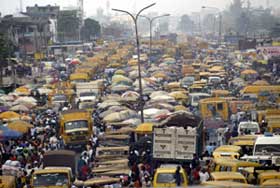Well-managed urbanisation can lead to sustainable growth: World Bank
Sakshi Education
Well-managed urbanisation can lead to sustainable growth but cities are a messy affair in India and other South Asian countries, says a report by the World Bank, issued on 24th September.


Titled ‘Leveraging urbanisation in South Asia', it says for the very poorest in India, Nepal, Bangladesh and Pakistan, the under-five years mortality rate is higher in urban than in rural settings. Besides, South Asia’s cities are notable for polluted air.
South Asia — which also has Afghanistan, Bhutan, the Maldives and Sri Lanka — produced only eight per cent of global gross domestic product in 2011, while having 14 per cent of the world’s urban population, the report said.
On the other hand, East Asia — China, Hong Kong, Japan, Mongolia, North & South Korea, and Taiwan — produced 29 per cent of global GDP, with 32 per cent of the urban population.
Messy urbanisation in India is reflected in the nearly 65.5 million who, in the country’s 2011 Census, lived in urban slums, as well as the 13.7 per cent of the urban population that lived below the national poverty line. Mismanaged cities are also reflected in the increasing sprawl that afflicts many Indian cities, the report said.
Among various other suggestions, it recommended land pooling and land readjustment to tackle the problems. This refers to land assembly through a process by which land parcels with different owners are combined into a larger, contiguous land area for more efficient subdivision and development. In this connection, it praised Gujarat for using the policy effectively.
The World Bank said there has been difficulty in dealing with pressures that increased urban populations put on basic services, infrastructure, land, housing and environment, fostering “messy and hidden” urbanisation. This has constrained the region’s full realisation of the prosperity and livability benefits of urbanisation.
The report said India added seven multi-city agglomerations between 1999 and 2010, for a total of 30; yet, cities are not able to take full advantage of these agglomerations. The largest metropolitan centres — Mumbai, Delhi, Bengaluru, Kolkata, Chennai, Hyderabad, and Ahmedabad — saw a 16 per cent loss in manufacturing jobs between 1998 and 2005 within 10 km of their city centres. On the other hand, job growth in their immediate peripheries increased by almost 12 per cent.
Even population growth has been fastest on the peripheries (beyond official administrative boundaries) of these major cities. For example, population growth for the district of Delhi was 1.9 per cent a year between 2001 and 2011, while the population growth in Gautam Budh Nagar (or Noida, its eastern periphery) was 4.1 per cent a year.
For many major Indian agglomerations, rapid growth in peripheral areas has been accompanied by evidence of stagnation at their core, where land management policies are limiting the extent and intensity at which land can be used by industry, commerce and housing
The economic push away from city cores is also imposing a burden on businesses and people by elevating market connection costs for firms and commuting costs for workers, with negative consequences for productivity, welfare, mobility, and livability in the major cities.
Important Points
South Asia — which also has Afghanistan, Bhutan, the Maldives and Sri Lanka — produced only eight per cent of global gross domestic product in 2011, while having 14 per cent of the world’s urban population, the report said.
On the other hand, East Asia — China, Hong Kong, Japan, Mongolia, North & South Korea, and Taiwan — produced 29 per cent of global GDP, with 32 per cent of the urban population.
Messy urbanisation in India is reflected in the nearly 65.5 million who, in the country’s 2011 Census, lived in urban slums, as well as the 13.7 per cent of the urban population that lived below the national poverty line. Mismanaged cities are also reflected in the increasing sprawl that afflicts many Indian cities, the report said.
Among various other suggestions, it recommended land pooling and land readjustment to tackle the problems. This refers to land assembly through a process by which land parcels with different owners are combined into a larger, contiguous land area for more efficient subdivision and development. In this connection, it praised Gujarat for using the policy effectively.
The World Bank said there has been difficulty in dealing with pressures that increased urban populations put on basic services, infrastructure, land, housing and environment, fostering “messy and hidden” urbanisation. This has constrained the region’s full realisation of the prosperity and livability benefits of urbanisation.
The report said India added seven multi-city agglomerations between 1999 and 2010, for a total of 30; yet, cities are not able to take full advantage of these agglomerations. The largest metropolitan centres — Mumbai, Delhi, Bengaluru, Kolkata, Chennai, Hyderabad, and Ahmedabad — saw a 16 per cent loss in manufacturing jobs between 1998 and 2005 within 10 km of their city centres. On the other hand, job growth in their immediate peripheries increased by almost 12 per cent.
Even population growth has been fastest on the peripheries (beyond official administrative boundaries) of these major cities. For example, population growth for the district of Delhi was 1.9 per cent a year between 2001 and 2011, while the population growth in Gautam Budh Nagar (or Noida, its eastern periphery) was 4.1 per cent a year.
For many major Indian agglomerations, rapid growth in peripheral areas has been accompanied by evidence of stagnation at their core, where land management policies are limiting the extent and intensity at which land can be used by industry, commerce and housing
The economic push away from city cores is also imposing a burden on businesses and people by elevating market connection costs for firms and commuting costs for workers, with negative consequences for productivity, welfare, mobility, and livability in the major cities.
Important Points
- For the very poorest in India, Nepal, Bangladesh and Pakistan, the under-five years mortality rate is higher in urban than in rural settings. Besides, South Asia’s cities are notable for polluted air
- South Asia produced only 8% of global gross domestic product in 2011, while having 14% of the world’s urban population
- Messy urbanisation in India is reflected in the nearly 65.5 million who, in the country’s 2011 Census, lived in urban slums, as well as the 13.7% of the urban population that lived below the national poverty line
- The report suggests measures, such as land pooling and land readjustment, among others, to tackle the problems
Published date : 25 Sep 2015 02:48PM













